Drosera aliciae
Drosera aliciae Raym.-Hamet
Family: Droseraceae
Common names: shepherd's crook sundew, alice sundew (Eng.); sondou (Afr.)
Introduction
Drosera aliciae, with its interesting mounding habit and its long-lived nature, is a wonderful carnivorous plant and is endemic to South Africa.
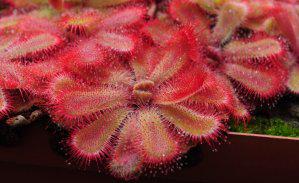
Description
Description
Drosera aliciae is a perennial carnivorous plant with a few, fairly thin, long roots. Wedge- to spoon-shaped leaves, up to 25 mm long and 7 mm wide, are tightly packed to form a dense, clumping basal rosette, 15-400 mm high. Leaves are often reddish and similar in size and are covered with reddish, sticky, glandular hairs.
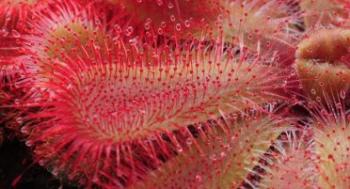
Older dead leaves are retained below, thus creating a mound. Petioles (leaf stalks) are absent but oval stipules up to 5 mm long and with three indentations are present on either side of the base of the lamina margin. The central lobe of the stipules is lance-shaped while the outer lobes are narrow, elongated bristles. Both marginal and discal (on the upper surface) tentacles are present. The lower surface of the lamina has a fine layer of short, dense hairs that lie flat.

The flowering stalk extends horizontally from the rosette before curving to become erect, giving rise to the common name, shepherd's crook. The single, stiff-stemmed inflorescence can reach up to 400 mm long and usually bears 2-12 simple, purple flowers which mature in ascending order. The three free styles are spoon-shaped at the top. Flowers appear from December to January.
Blackish-brown seeds are tapered on either end with a thick hard outer coating on both sides. The seed capsule is oval.
Conservation Status
Status
This species is not threatened.
Distribution and habitat
Distribution description
Drosera aliciae is endemic to South Africa and is a common species in the Western Cape, its distribution extending into the Eastern Cape. It occurs at altitudes from 30 to 2000 m.
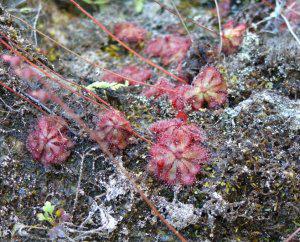
This marsh plant is usually found in damp, peaty, exposed areas on stream and river banks or in seeps.
Derivation of name and historical aspects
History
The genus Drosera was named by Linnaeus in 1753 and consists of ± 126 species of which 23 occur in South Africa. Drosera gets its name from the Greek word, droseros, meaning dewy. The species was first named and published in the Journal de Botanique in 1905 by Raymond-Hamet (1890-1972) who was 15 years old at the time. He named Drosera aliciae in honour of Dr. Alice Rasse who encouraged him to study the sundew family.
Synonyms include Drosera curviscapa Salter var. curviscapa and Drosera curviscapa Salter var. esterhuyseniae Salter (Obermeyer 1970).
Drosera aliciae is closely related to D. natalensis and they can become difficult to distinguish in the Eastern Cape where their distributions overlap. D. aliciae is a more compact plant and the stipules are divided in three while D. natalensis has more irregularly fringed stipules and a more lax habit.
Some of the other commonly known species within this family are the prolific D. trineriva, the tufted D. pauciflora and the largest of the South African species, D. regia.
Ecology
Ecology
Flowers open very briefly for a few hours with good sunlight. They can be pollinated by insects but are usually self-pollinated. When the seeds are ripe, their capsules open to release fine, lightweight seeds which fall out and are dispersed near the parent plants. Probably the most interesting characteristic of this plant is its ability to digest nutrients, especially the nitrogen it requires, from insects caught in its stalked tentacles. Different types of glandular growths include marginal tentacles situated near the lamina margins, discal tentacles which are shorter and disc-like on the upper leaf surfaces, digestive glands filled with red fluid and glandular hair-like growths on the inflorescence. The tentacles are sensitive and mobile. The stalks end in a bulbous head in which the glandular cells occur. These glands secrete a glistening, sticky, clear fluid used to trap and retain prey. There is speculation that the fluid is slightly sweetly scented to attract insects. The fluid contains a weak acid and enzymes that digest the soft parts of the prey. The sensitive tentacles are able to detect caught prey and produce more dew to entrap their victims. Neighbouring tentacles then mobilize and slowly lean over to engulf the hapless victim. The lamina itself may also fold over to enclose or suffocate larger prey and to allow for better absorption. As sensitive as these tentacles are, they are able to distinguish between a meal and other stimuli and do not, for example, respond to water droplets.
Uses
Use
Droseras make fascinating house and conservatory plants around the world but are better suited to being grown outdoors. Keep them under roof if you wish to retain their vivid red colouration. Plants can also be brought indoors for short periods for display. Drosera aliciae is a hardy, long-lived carnivorous plant, but not necessarily the easiest for novices.
Drosera species have also been recorded for use against various ailments. Extracts of the leaves were used externally for warts, corns and sunburn. Disorders such as tuberculosis, asthma, coughs, eye and ear infection, liver pain, morning sickness, stomach conditions, syphilis, toothache and intestinal problems were treated internally with teas or extracts made from the leaves. The tea was also used as a tranquilizer, and some believe that it has aphrodisiac properties. Antispasmodic agents have been found by scientists in some Drosera species.
Growing Drosera aliciae
Grow
Drosera aliciae grows best in 1 part sand or silica grit: 1 peat or sphagnum moss in 9-15 cm pots. It is important not to over-pot plants. Taller rather than wider pots are ideal for Drosera to thrive. Pot plants up according to their size and the depth needed for their long, although few, roots. Place the potted plants in a 10-30 mm deep saucer filled with fresh water to keep them moist at all times. Allow the saucer to dry out occasionally so that the medium can aerate. This will not harm your plants as long as the moisture content in the medium is still high. Place in a northern or eastern situation for best sunlight if growing indoors. Grow in full sun to semi-shade outdoors.
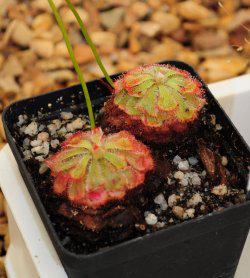
Sundews are easily propagated by seed. Prepare a 90 mm pot with growth medium and water well. In autumn sow fresh seeds on the surface in moist growth medium. Do not cover with growth medium. Place in a semi-shady position. Seeds should germinate in 2-4 weeks.
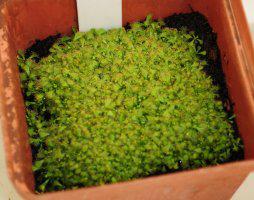
For vegetative propagation partially cover healthy living root or leaf cuttings with growth medium. Place in a well-lit area but not in direct sunlight. Cover pots with plastic to retain humidity. Once young leaves develop, pierce the plastic to allow for acclimatization and hardening off. Acidic or epiphytic foliar feed may be used once a month at ¼ recommended strength.
Ironically, the carnivorous plants are attacked by insect pests. Aphids, mealy bug and thrips cause deformity in new growth. Treat with a diluted pesticide or remove pests by hand. Never use a soap-based insecticide. Drying out can cause drooping and the decrease in mucilage production. Watering and keeping the plant moist will revive them. Dew production may stop after transplanting or if the leaf comes into contact with inquisitive hands. New foliage will, however, grow and continue to produce dew. Mature plants die off from time to time, but usually young shoots develop off their rhizomatous stems or roots, so wait a few weeks before you throw them out!
References
- Goldblatt, P. & Manning, J.C. 2000. Cape plants. A conspectus of the Cape flora of South Africa. Strelitzia 9. National Botanical Institute, Pretoria.
- Le Roux, A. & Wahl, Z. (photographer). 2005. . South African Wild Flower Guide 1, edn 3. Botanical Society of South Africa, Cape Town.
- Leistner, O. A. 2000. Seed plants of southern Africa: families and genera . Strelitzia 10. National Botanical Institute, Pretoria.
- Obermeyer, A.A. 1970. Droseraceae in L.E. Codd, B. de Winter , D.J.B. Killick & H.B. Rycroft, Flora of southern Africa 13. Botanical Research Institute, Pretoria and National Botanic Gardens, Kirstenbosch.
- Smith, C.A. 1966. Common names of South African plants. Memoirs of the Botanical Survey of South Africa No. 35.
- http://www.lookfordiagnosis.com/images.php?term=Drosera&photo_id=3176658157&lang=1
- http://www.omnisterra.com/botany/cp/pictures/drosera/0075.htm
Credits
Monique McQuillan
Kirstenbosch National Botanical Garden
September 2012
Plant Attributes:
Plant Type: Perennial
SA Distribution: Eastern Cape, Western Cape
Soil type: Sandy
Flowering season: Early Summer
PH: Acid
Flower colour: Pink
Aspect: Full Sun
Gardening skill: Challenging
Special Features:
Horticultural zones








Rate this article
Article well written and informative
Rate this plant
Is this an interesting plant?
Login to add your Comment
Back to topNot registered yet? Click here to register.